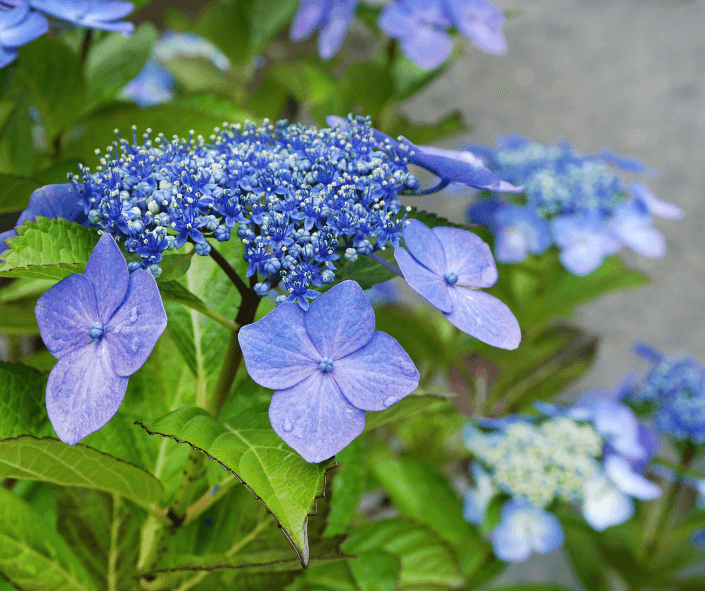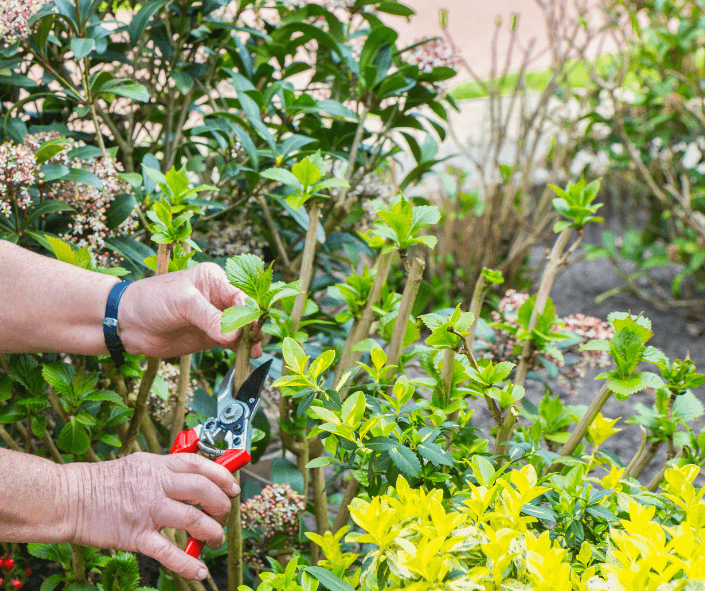
In James McNeil Whistler’s famous 1871 painting, Whistler’s Mother, the title subject wears a lace cap and does not appear very happy about it. Most of us would probably have the same expression if we had to don similar headgear. Installing a lacecap hydrangea in the garden is a completely different experience and is highly likely to produce smiles instead of frowns.
Mopheads Versus Lacecaps

The garden lacecaps are eye-catching varieties of bigleaf or mophead hydrangea (Hydrangea macrophylla) or Japanese mountain hydrangea (Hydrangea serrata), and it is the floral “lace” that makes them different. Instead of the large, globe-shaped flowerheads familiar to hydrangea lovers far and wide, lacecaps have flattened flowerheads (technically called corymbs), characterized by wide centers of small true flowers, surrounded by lacy outer borders of large sterile florets. Depending on the variety, lacecaps bloom in the same colors as mopheads, bluer in acid soils, red or pink in alkaline soils, and lavender or purple when the soil is neutral. All the macrophylla hydrangeas feature the same large, medium to dark green leaves that are shaped like toothed teardrops. Japanese mountain hydrangeas tend to be smaller in stature and the leaves have more toothed, or serrated, edges.
Japanese Origins

Lacecaps have been around for some time. The first wild shrubs were discovered in Japan in the 1870s by English plant hunter Charles Maries, just a few short years after Whistler immortalized his mother. By the end of the decade, two varieties, the white-flowered ‘Veitchii’ and the pale blue or pink-flowered ‘Mariesii’ had been introduced commercially in Europe. The two are still available through some retailers today.
Modern Developments

Modern breeders in Japan, Switzerland, the United States, and elsewhere have produced several other winning varieties, sometimes marketed as part of trademarked series. BLUE WAVE is the new, trademarked name of an old variety, ‘Mariesii Perfecta’, which features vibrant blue flowers and was introduced into commerce in 1904. It is a compact variety, with a 3.5-foot height and spread. ‘Lady in Red’ is even smaller at two to three feet wide and tall, boasting dramatic dark red stems and leaf veins. Its leaves turn scarlet in the fall. For even more drama, try ‘Zorro’, with near-black stems, and red fall foliage.
The opulent Japanese variety ‘Izu no Hana’ bears double outer florets with pointed petals. For even more petals, ‘Lanark White’ offers small blue florets that jostle in the flowers’ centers with a number of the larger sterile ones that are repeated in the outer margins. The overall appearance is that of a lacecap/mophead mash-up.
Variegated leaves can add interest to the garden, and varieties like Hydrangea macrophylla var maculata feature the characteristic green, elliptical leaves edged in cream.
Pruning and Blooming

As with other mophead hydrangeas, traditional lacecaps flower on “old wood”, which means this year’s flowers grow on last year’s stems. Therefore, the best time to prune them is in the summer after their big flush of blooms has past. Another problem with the trait is that the buds can be frozen by late spring frosts, resulting in a loss of summer blooms. Newer varieties, like ‘Twist and Shout’ (part of the ENDLESS SUMMER® series of lacecaps and mopheads), bloom on “new wood” or stems produced in the year of bloom, which solves the spring frost problem. If you have experienced hydrangea disappointment when plants produce few or no flowers in any given year, it is worth seeking out new varieties to fill holes in your planting scheme. (Click here for a detailed hydrangea pruning guide from Proven Winners®.)
Hydrangea Hydration and Care

All bigleaf hydrangeas prefer uniformly moist soil and light shade. Heavier shade will result in fewer blooms. When planting, add a rich soil amendment, like Fafard® Premium Natural and Organic Compost. Mulching is also a good idea for moisture-loving lacecaps. The shrubs will succeed in large containers, as long as you water regularly throughout the growing season and feed with commercial plant food applied and diluted according to the manufacturer’s directions. If pesky spring frosts are a routine occurrence and you love your mature, traditional mophead and/or lacecap hydrangeas, you can wrap yours in comfy layers of burlap in the fall and remove it in spring when all danger of frost has passed. This doesn’t look particularly attractive, but may greatly improve the chance of abundant summer blooms.

















